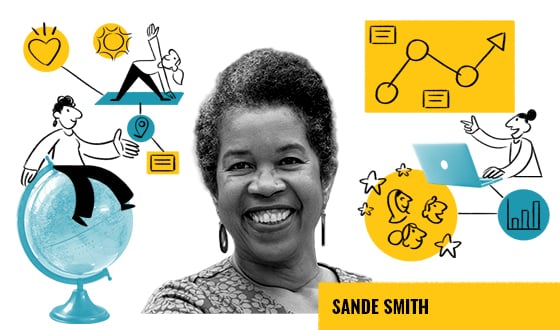visual thinking: Picture-literate in six brilliant weeks
Sande Smith, Communications Director at the California Wellness Foundation, is passionate about using visual thinking to drive positive change. Through her leadership coaching practice, she helps individuals and organisations develop their visual thinking skills to enhance creativity, communication, and problem-solving. Here, as a graduate of Scriberia's visual thinking diploma, Sande shares why skills are crucial for anyone looking to make a meaningful impact.
When it comes to finding a way through dense issues and challenges, Sande realised how often standard comms tools miss the mark. So she resolved to become a better visual thinker.

As a communications specialist, what brought you to the Scriberia Diploma?
None of us would question how important it is to be word-literate. You have to be able to write and speak to convey emotion, express urgency, communicate a vision, and tell a story in a way that connects to the experiences people are having. But while words allow us to make sense in a sequential fashion, visual thinking allows us to make sense in a spatial, whole-picture way.
Communication professionals often understand the power of images but lack the skills to process and convey ideas visually. I realised that many of our diagrams and Powerpoint slides weren’t working as well as they could. And I wanted to do better. That’s how I got interested in training with Scriberia.
FIND OUT MORE ABOUT THE DIPLOMA...
What impact has the Diploma had on the way you work?
The California Wellness Foundation is focused on advancing community health, which includes making grants to organizations working on economic security, movement building, increasing access to health care, and reducing gun violence. Recently we did a project with a firm to help us think about how we support narrative change. They did a great job in helping us think about narrative change, but the end product was text-heavy. Given that my team is so busy, I wanted to find a way to create an engaging visual that they’d want to refer to and share with others. So the challenge was, how could I give the team something to look at that would help them see the trajectory of change they want to support, and document the investments they want to make?
After the Diploma course, I realised I needed to simplify. I went through the document and pulled out the most important parts. Then I did a bunch of diagrams and commissioned an illustrator to work with me to make an image showing a journey. So now we have this dynamic, fun-to-look-at document that my team will be able to use as a slide – both as a reference for themselves and as a communication tool when they meet with others. That’s a direct result of going through the Scriberia programme.
You don’t need to draw complicated things, just simple shapes, to get the idea down. If you can draw a circle, that’s enough. This really is a tool for everyone.
Sande Smith, diploma graduate
As a coach, how do you see visual thinking as a tool for responding to challenges?
In a world where we're constantly bombarded, emotionally and intellectually, by a tonne of information, it’s easy to get overwhelmed. We spend a lot of time and energy thinking, what are we going to do? How are we going to see our way through? Visual thinking – I might even call it visual processing – is so helpful for grounding you. How do you help yourself move through the morass? How do you communicate with others? How do you share your thinking in a form that helps them see what you mean? Then how do you document, maintain and support yourself as you go to the next level? Visual thinking and expression is absolutely key. You don’t need to draw complicated things, just simple shapes, to get the idea down. If you can draw a circle, that’s enough. This really is a tool for everyone.
Why was this course the right one for you?
I loved the structure of the Diploma. I’ve done two-day classes on graphic facilitation and they’ve been great. But the diploma gives you six weeks of time to really learn.You do something in class and then you do your assignments between classes. It's designed to help you practise and then start to build your confidence. Scriberia has given a lot of thought to how to build people's capacity and help them make the connection between drawing and meaning. How to move from drawing to sketchnoting, to being able to illustrate what you’re hearing, to simplifying that message, to manipulating those ideas, to powerful storytelling… and so on. It’s very systematic, very effective and a lot of fun.
